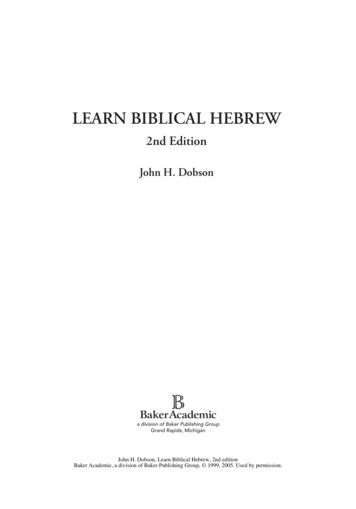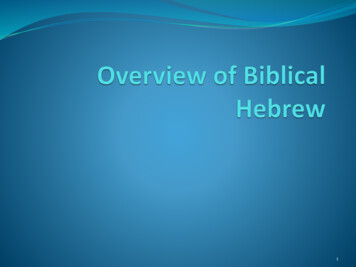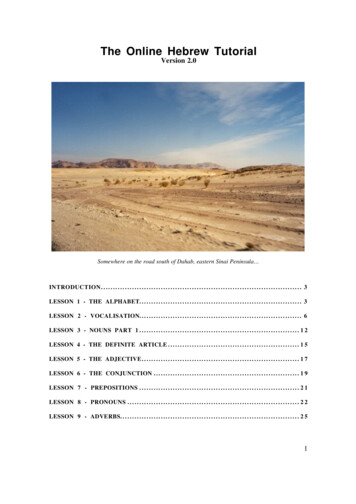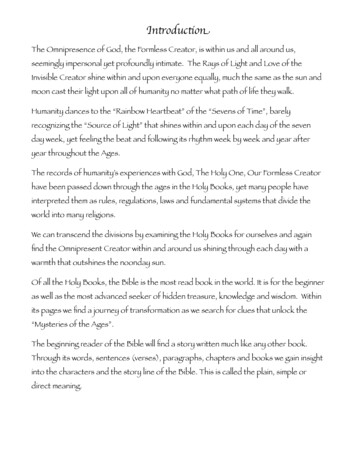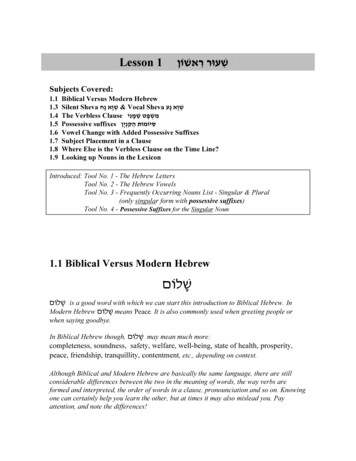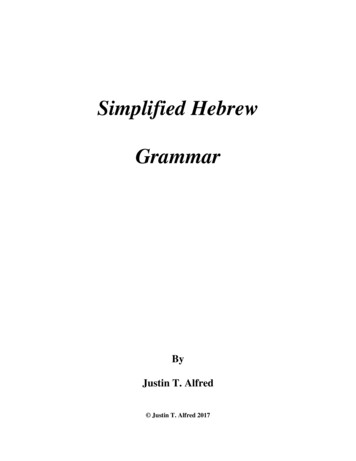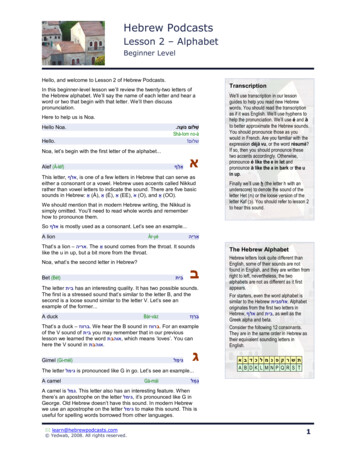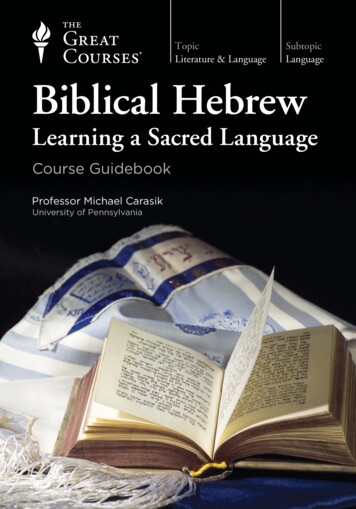
Transcription
TopicLiterature & LanguageSubtopicLanguageBiblical HebrewLearning a Sacred LanguageCourse GuidebookProfessor Michael CarasikUniversity of Pennsylvania
Published byTHE GREAT COURSESCorporate Headquarters4840 Westfields Boulevard Suite 500 Chantilly, Virginia 20151‑2299[phone] 1.800.832.2412 [fax] 703.378.3819 [ web] www.thegreatcourses.comCopyright The Teaching Company, 2018Printed in the United States of AmericaThis book is in copyright. All rights reserved. Without limiting the rights under copyright reservedabove, no part of this publication may be reproduced, stored in or introduced into a retrieval system,or transmitted, in any form, or by any means (electronic, mechanical, photocopying, recording, orotherwise), without the prior written permission of The Teaching Company.
Michael Carasik, PhDAdjunct Assistant Professorof Biblical HebrewUniversity of PennsylvaniaMichael Carasik has taughtbiblical Hebrew since 1991,most recently (since 2000) at theUniversity of Pennsylvania, wherehe is Adjunct Assistant Professorof Biblical Hebrew and a memberof the Faculty Working Group onRecovered Language Pedagogies.He has also taught at HebrewCollege, Northeastern University, the University of Delaware, GratzCollege, the Reconstructionist Rabbinical College, and Saint Joseph’sUniversity. In addition, he has taught adults in the Kerem, Melton, andMe’ah/ConText programs.Dr. Carasik earned his bachelor’s degree from New College of Florida.While working as a computer programmer, he earned a second bachelor’sdegree and a master’s degree in Jewish Studies from Spertus College. Hethen decided on a career change and earned a second master’s degree and adoctorate in Bible and Ancient Near East from Brandeis University.Dr. Carasik is the creator, editor, and translator of The Commentators’Bible (The JPS Miqra’ot Gedolot)—an English-language version of thetraditional Jewish Bible commentaries on Genesis, Exodus, Leviticus,Numbers, and Deuteronomy, dating from the 11th to the 16th centuries.He has also written a scholarly monograph titled Theologies of the Mind inProfessor Biographyi
Biblical Israel, a description of the Israelite understanding of psychologyas revealed in the Bible, and a book for general readers called The Bible’sMany Voices, a layperson’s guide to what the human authors of the Biblemeant by their writing. In addition, he has published numerous articles,reviews, reference book entries, and translations, ranging from medievaltexts to a play by A. B. Yehoshua.In addition to his academic writing and teaching, Dr. Carasik has workedfor the National Hebrew Proficiency Guidelines Committee, has beena columnist for Jewish Ideas Daily, has spoken at synagogues around theUnited States, and has served the Philadelphia Jewish community asvice president of the Center City Eruv Committee and president of theCenter City Kehillah. He is also the weekday Torah reader at historiccongregation Kesher Israel in Philadelphia.Dr. Carasik has hosted the weekly Torah Talk podcast since 2009 and blogsas The Bible Guy on WordPress.com. öiiBiblical Hebrew
Table of ContentsIntroductionProfessor Biography . . . . . . . . . . . . . . . . . . . . . . . . . . . . .Course Scope . . . . . . . . . . . . . . . . . . . . . . . . . . . . . . . . .i1Guides1Studying Biblical Hebrew . . . . . . . . . . . . . . . . . . . .32Learning the Aleph Bet . . . . . . . . . . . . . . . . . . . . . .63The Tiberian Vowel System . . . . . . . . . . . . . . . . . . .104Roots of Semitic Verbs . . . . . . . . . . . . . . . . . . . . . .165Hebrew Verb Forms and the Definite Article . . . . . . . . .196Hebrew’s Attached Prepositions . . . . . . . . . . . . . . . . .237Adjective Forms and Agreement in Hebrew . . . . . . . . . .278Irregular Hebrew Nouns and Adjectives . . . . . . . . . . . . 319Hebrew Pronouns and Pronominal Suffixes . . . . . . . . . .3510How Hebrew Letters Behave . . . . . . . . . . . . . . . . . .4111Perfect and Imperfect Hebrew Verbs . . . . . . . . . . . . . .4512Segholate Nouns and Pausal Forms . . . . . . . . . . . . . . .4913The Construct Form: Hebrew’s Trailer Hitch . . . . . . . . .5214Forming Hebrew Construct Chains . . . . . . . . . . . . . .5515Hebrew Verb Classifications: Binyanim . . . . . . . . . . . . .5816Question Words in Hebrew . . . . . . . . . . . . . . . . . . .6217Hebrew Participles . . . . . . . . . . . . . . . . . . . . . . . .6618Counting in Hebrew . . . . . . . . . . . . . . . . . . . . . . .70Table of Contentsiii
19Hebrew Roots with Guttural Letters . . . . . . . . . . . . . .7620Hebrew’s Lamed‑Hey Roots . . . . . . . . . . . . . . . . . . .8021Hebrew Roots Beginning with Yud . . . . . . . . . . . . . . .8422Irregular Hebrew Verbs . . . . . . . . . . . . . . . . . . . . .8723Hebrew’s Hollow Verbs . . . . . . . . . . . . . . . . . . . . .9224The Infinitive in Hebrew . . . . . . . . . . . . . . . . . . . .9725Jussives, Cohortatives, and “Hava Nagila” . . . . . . . . . .10126The Imperative Form in Hebrew . . . . . . . . . . . . . . . 10527Verbs of the Hiphil Binyan . . . . . . . . . . . . . . . . . . 10928Piel Verbs and Passive Binyanim . . . . . . . . . . . . . . . . .11329Reflexive Binyanim: Niphal and Hitpa’el . . . . . . . . . . . .11730Reading the Bible in Hebrew: Joshua 1 . . . . . . . . . . .12231Geminate Verbs and Reading Numbers 22 . . . . . . . . . .12532Hebrew’s Object Suffixes . . . . . . . . . . . . . . . . . . .12833Hebrew Oaths and Other Idioms . . . . . . . . . . . . . . . 13034Understanding Hebrew Punctuation Marks . . . . . . . . .35Choosing a Hebrew Bible . . . . . . . . . . . . . . . . . . . 14036Helpful Hebrew Reference Books . . . . . . . . . . . . . . . 143133Supplementary MaterialNumbers 22 . . . . . . . . . . . . . . . . . . . . . . . . . . . . . . . 146Answers to Assignments and Challenges . . . . . . . . . . . . . . . . 148Index of Charts . . . . . . . . . . . . . . . . . . . . . . . . . . . . . . 214Biblical Books . . . . . . . . . . . . . . . . . . . . . . . . . . . . . . 216Bibliography . . . . . . . . . . . . . . . . . . . . . . . . . . . . . . . 218ivBiblical Hebrew
BIBLICAL HEBREWLearning a Sacred LanguageThis course will introduce learners to biblical Hebrew—the languagein which most of the Jewish Bible, the Tanakh, and its Christianequivalent, the Old Testament, was written. (A few chapters of the booksof Ezra and Daniel are written in a related language, Aramaic.) The courseis designed for learners with no previous knowledge of Hebrew. If youdo already know some Hebrew, you will discover that even in the earliestlessons, things you never noticed—or things you knew “instinctively”—will be carefully explained. People learn much more easily when they areready to learn, which means that learners at every level will benefit fromwatching some or all of the video lessons multiple times.The course begins with the two most important elements of the biblicalHebrew writing system: the consonants, in which the oldest biblicaltexts in existence appear; and the vowels, developed only late in the1st millennium CE, 1,000 years after the latest texts in the Bible werewritten. You will learn just a bit of the biblical punctuation system, whichyou will learn about in greater depth toward the end of the course.A major focus of the course is the grammatical building blocks oflanguage: adjectives, nouns, and verbs—almost all of them the sameas are used in rabbinic, medieval, and modern Israeli Hebrew. But thecourse will combine this more technical aspect of language learning withthe kind of listen-and-learn language acquisition through which we alllearned our native languages. The course will start slowly, with a focuson Genesis 1:1–5 (the first paragraph of the Bible, recounting the firstday of creation), and will continue by turning to the creation of the sun,moon, and stars. The course will also visit the story of Cain and Abel, theadventures of Abraham and Sarah, and other biblical texts that may ormay not be familiar to you.Course Scope1
The essential goal of this introductory course is to give you the skills youwill need to read through the narrative texts of the Bible from Genesisthrough Kings. The same skills will give you access to the later Hebrew ofthe Persian period and the more complex syntax and vocabulary of poetry,but for simplicity’s sake, the course will mostly avoid these later and/ormore complicated texts. The course will, however, expose you to almost allof the words used 100 times or more in the Bible.Learning a language is like learning how to play a musical instrumentor developing an athletic skill. Almost everyone will be stronger at someaspects of the task than at others. More importantly, almost everyonewill need to put in some work and a great deal of repetition to gettheir language skills where they want them to be. Each lesson will haveexercises, with answers, to help you focus on the important takeaways ofthat lesson.The course will also focus on a particular chapter of the Bible: Numbers 22,the story of Balaam and the ass. Each lesson will provide a challenge thatyou can meet by looking at Numbers 22 in Hebrew (feel free to use Englishtranslations, especially at the beginning of the course, to give you an extraboost). By returning over and over again to that one chapter, reading it andlistening to it in Hebrew, you will give yourself the opportunity to learnsome Hebrew the natural-language way as well as the grammatical, rulesbased way. By the end of the course, when you read that entire chapter,you will be able to feel that you are not just decoding it but understandingit. That will give you not only the skills but also the confidence to moveforward with your study of Hebrew. ö2Biblical Hebrew
Lesson 1Studying BiblicalHebrewIn this first lesson, you will learn how to read biblicalHebrew. The Bible has been translated into Englishmultiple times, each with its own interpretations. Forthis reason, it’s worth learning how to read the Biblein its original language—so that you can make yourown decisions about what the Bible really means. Inaddition, you will be able to appreciate the stories andpoetry in the Bible (no small portion of it) that employuntranslatable literary artistry.Lesson 1 ö Studying Biblical Hebrew3
GRAMMARNOTE:I f no accent is marked on the Hebrew word, the accent falls on thelast syllable. If some other syllable has the accent, it is marked withthe symbol ֫ . Example: מֶ֫ל ְֶך . Biblical phrases retain their originalpunctuation.Vocabulary אֹור light אֱֹלהִים God, gods וַיֹּ ֫אמֶר and he said [form of verb ]אָמַר יְהִי let there be, let it be [form of verb ]הָי ָה ACTIVITIESQuestionsww What are the three different components of the biblical Hebrewwriting system?ww How did history shape the Bible?ww How did the three different stages of Hebrew writing change howpeople read the Bible?4Biblical Hebrew
Practiceww Practice reciting the last word of the book of Psalms [ ]הַֽל ְלוּ־יָֽהּ .ww Practice reciting Gen. 1:3 [ ]וַיֹּ ֥אמֶר אֱֹלהִ ֖ים יְהִ֣י אֹ֑ור וַֽיְהִי־אֹֽור׃ andstart associating each of its words with the English meaning.CHALLENGEww Find every occurrence of the word “( וַיֹּ ֫אמֶר and he said”) in Numbers22. [A copy of Numbers 22 for this and all future challenges can befound on PAGE 146.]The solution is provided on PAGE 149.CLICK the page numbers to navigate.To go back to the page you came from,PRESS Alt on a PC or on a Mac.On a tablet, use the bookmarks panel.You control the pace ofthis course. You can, andshould, go back to thebeginning of any lesson atany time, as many timesas you need to. That kindof repetition is all part oflearning a language.Lesson 1 ö Studying Biblical Hebrew5
Lesson 2Learning the Aleph BetIn this lesson, you will learn the 22 consonants of theHebrew alphabet—block letters that are, and were,enough to write Hebrew under most circumstances.It’s called the aleph bet because aleph is the first letterof the Hebrew alphabet and bet is the second letter.Similarly, in English it’s called the “alphabet” because“alpha,” the first letter of the Greek alphabet, isfollowed by “beta.” It’s important to learn the Hebrewalphabet in alphabetical order not only to be ableto find words in the dictionary, but also to be ableto count.6Biblical Hebrew
GRAMMARThe Hebrew AlphabetLETTERSOUNDNAME א [silent]aleph בּ b ב vSOUNDNAME ל llamed מם mmem נן nnun ג ggimmel ס ssamekh ד ddalet ע [silent] ה hhey פּ p ו vvav פף f ז zzayin צץ tstsade ח khhet ק kkof ט ttet ר rresh י yyud שׁ sh כּךּ k שׂ s כך kh ת tbetkafLETTERayinpeyshintavLesson 2 ö Learning the Aleph Bet7
ww The letters kh indicate a guttural sound like the ch in the name ofJ. S. Bach or Loch Ness.ww Five letters— כ , מ , נ , פ and —צ are written differently when theyoccur at the end of a word. The second letter in the chart is thefinal form.ww Letters with dagesh are given in the chart only when dagesh changes thesound of the letter in modern pronunciation. So, כ , ב , and פ appeartwice in the chart, once with dagesh and once without.ww שׁ and שׂ are two different consonants written with a single symbol in thealphabet; dictionaries of biblical Hebrew group words beginning withthese letters in two separate sections. Several other letters in the alphabetrepresent more than one original consonant, but the writing system didnot preserve these distinctions.Vocabulary8 אֶחָד one בָּבֶל Babylon עֶ֫בֶד slave בֹּ֫קֶר morning עֶ֫רֶ ב evening זָהָב goldBiblical Hebrew יֹום day
ACTIVITIESQuestionsww What effect did the development of the alphabet have on humancivilization?ww How did our English alphabet develop from the original one? Howis it similar to and different from the Hebrew alphabet? What otheralphabets currently in use are related to these alphabets?ww Which letters have separate forms used always and only at the endof a word?ww What do you recognize in Gen. 1:5? וַיִּקְרָ ֨א אֱֹלהִ֤ים ׀ ל ָאֹור֙ יֹ֔ום וְל ַחֹ֖שְֶׁך קָ ֣רָ א לָ֑יְל ָה וַֽיְהִי־עֶ֥רֶ ב וַֽיְהִי־בֹ֖קֶר יֹ֥ום אֶחָ ֽד׃ Practiceww Try to memorize the Hebrew of Gen 1:5b.ww Practice singing or reciting the Hebrew alphabet in alphabetical order.CHALLENGEww Find every consonant in the Hebrew alphabet—includingand all 5 final forms—in the text of Numbers 22. ׁש and ׂש ww While you are searching, look for the etnaḥta in every verse.The solution is provided on PAGE 151 .Lesson 2 ö Learning the Aleph Bet9
Lesson 3The TiberianVowel SystemIn Hebrew, the letters ה , ו , and י were, and are, usednot only as consonants (h, v, and y, respectively) butalso to hint at vowel sounds. But toward the end of the1st millennium CE—11 or 12 centuries ago, probablyas a response to what Muslims were doing with theKoran—Jews began to develop various systems tomark the vowels explicitly. One of these systems, theTiberian system, established itself and has been usedexclusively for the last thousand years or so. You willlearn the Tiberian vowel marks in this lesson.10Biblical Hebrew
GRAMMARConsonants That Sound AlikeThe consonants in this table arepronounced (or not pronounced)alike by almost all speakers of Hebrewtoday. In biblical times, they all haddistinctive, different pronunciations,so speakers and writers would notconfuse them. Note the presence orabsence of dagesh in ב and כ , whichchanges their sound. Using כ ratherthan כּ does not change the meaningof a word; using כּ rather than ק doeschange the meaning of a word.CONTEMPORARYPRONUNCIATION ע , א ו , ב [silent]v כ , ח kh [as in J. S. Bachor Loch Ness] ת , ט t ק , כּ k שׂ , ס sVowelsAll vowels are printed here under (or after) silent א but may occur withany consonant.VOWELLONGSHORTULTRASHORTְ א shevaA (ah) אָ qamatz (ah) אַ pataḥ (ah)ֲ א ḥataf-pataḥ (ah)I (ee)ֵ א tsere (ey)ִ א ֱ א ḥataf-seghol (eh) אֵי tsere-yud (ey)ֶ א seghol (eh) אִי ḥireq (ih)ḥireq-yudLesson 3 ö The Tiberian Vowel System11
VOWELLONGSHORTULTRASHORTU (oo) אוּ shuruq (oo)ֻ א qubbutz (oo)ֳ א אֹו ḥolem (oh) אָ qamatz qatanֹ א ḥolem ḥaserwwḥataf-qamatz (oh)(oh)(oh)ְ א sheva is pronounced like the first a of “Maria” or the first eof “Jerusalem.”wwְ א sheva is also used (unpronounced) to mark the end of a syllable.ww In the suffixesis silent.(as in )אֱֹלהָיו and(as in )אֱֹלהֶיָך , the י The Dageshww The dagesh indicates a doubled, or lengthened,consonant, for grammatical or etymological reasons.For example: 12Another consonant (most often a )נ has assimilated to theconsonant with the dagesh.The binyanim Piel, Pu’al, and Hitpa’el are characterized by doublingof the second radical.Geminate roots, where the second and third radicals are the same,sometimes display that letter only once but with a dagesh.Biblical Hebrew
ww Dagesh can not appear in the gutturals ע , ח , ה , א , or in ;ר whenit should appear in one of those letters, the previous vowel is oftenlengthened to compensate (more commonly with א or )ר .ww Dagesh appears, not for grammatical or etymological reasons, in theletters ( בגד כפת the beged-kefet letters) when they are not precededby a vowel. This is called dagesh lene or dagesh qal (i.e., an insignificantdagesh). When a beged-kefet letter has a dagesh and is preceded by avowel, it should be considered doubled/lengthened. This is calleddagesh forte or dagesh ḥazaq (i.e., a grammatically or etymologicallysignificant dagesh).ww Either kind of dagesh will change the sound of the letters כ , ב , and פ (see the Hebrew Alphabet chart on PAGE 7). The change in sound doesnot alter the meaning of the word.ww The dot in ( הּ only in final position in the word with no followingvowel) is not a dagesh (which cannot appear in )ה . This dot is calledmappiq (from an Aramaic word meaning that it “brings out” thesound of the ;)ה it indicates that this is an “original” (consonantal) ה , unlike the ה of 3rd-H roots, which replaces an original י or ו . It issometimes a genuine root letter but more often indicates a 3rd femininesingular suffix.ww The dot in a shuruq [as in the word ]קוּם is also not a dagesh but simplya mark indicating the vowel. Confusingly, a consonantal ו can have adagesh, as in the Piel verb “( צִוּ ָה he commanded”). Note that in קוּם ,the וּ is sandwiched in between two consonants and therefore must be avowel; in צִוּ ָה , the וּ is sandwiched in between two vowels and thereforemust be a consonant.Lesson 3 ö The Tiberian Vowel System13
Vocabulary בֶּ֫ג ֶד כֹּל ל ָיְל ָה ֫ סֵ֫פֶר פֶּה קָרָ א garment, article of clothingallnightbook, document, scrollmouthhe calledACTIVITIESQuestionsww What are the three different groupings of vowel sounds in Hebrew?Which Hebrew consonants can be used to represent each group?ww What are the two different functions of the sheva?ww What are the two different functions of the dagesh?ww What are the six beged-kefet letters?14Biblical Hebrew
ASSIGNMENTww Read the following names of biblical places and characters and identifythem in English: צִיֹּון יַעֲקֹב אַבְרָ ם רְ אוּבֵן ִישְׁמָעֵאל אָדָ ם רָ חֵל ִישְׂרָ אֵל דָּ ו ִד שִׁמְעֹון ל ֵאָה י ְהוּדָ ה שָׂרָ ה משֶֹׁה ִיצְחָק תָּמָר עֵשָׂו י ְרוּשָׁלִַ֫ים CHALLENGEww Find every example of the expression וַיֹּ ֫אמֶר אֶל (“Someone said to someone else”) in Numbers 22.ww While you are searching, see how many examples you can find ofphrases of the zaqef qaton mark that often ends a biblical phrase.Solutions are provided on PAGE 154.Lesson 3 ö The Tiberian Vowel System15
Lesson 4Roots of Semitic VerbsEvery verb, and almost every noun and adjective,in Hebrew can be thought of as being based on agroup of three consonants, which themselves are nota word but represent an idea. The three consonants,as a group, are called a root. It’s a concept that theEnglish language doesn’t really have. In Hebrew, youcan replace those three root letters—or radicals, fromthe Latin word radix, meaning “root”—in manywords with a different set of three to get a word thatworks the same way in the language. The root, in theabstract, has a basic meaning, and the pattern that youplug each root into also retains its basic meaning.16Biblical Hebrew
GRAMMARVocabulary אָדֹון lord, sir אֵל God אֶל to יהוה the Tetragrammaton, personal name ofthe Israelite God, pronounced adonai מֶ֫ל ְֶך king מָל ְַך he reigned שַׁדַּ י Shadai, AlmightyACTIVITIESQuestionsww How is the idea of roots similar to or different from the way Englishoperates?ww What might the different names for God and the way they are used inthe Bible indicate?Lesson 4 ö Roots of Semitic Verbs17
ASSIGNMENTww Determine the triliteral (three-letter) root of the related words ineach column: מְלַמֵּד וַיִּשְׁמֹר וַיֹּ ֫אמֶר לִמַּדְ תִּי וּלְשָׁמְרָ הּ ל ֵאמֹר ִילְמְדוּן מִשְׁמַרְ תִּי אִמְרֵ יכֶם לְלַמֵּד הִשָּׁמֶר אָמְרָ ה תְּלַמְּדֵ ם וּשְׁמַרְ תֶּם הָאֹמְרִ ים מְלֻמְּדֵ י שְׁמֻרֹות הֶאֱמִ ֽירְ ָך CHALLENGEww Find five examples in Numbers 22 of אֱֹלהִים and five of theTetragrammaton.Solutions are provided on PAGE 157.18Biblical Hebrew
Lesson 5Hebrew Verb Formsand the Definite ArticleThis lesson includes a major overview of verbs.There are five different verb forms in biblicalHebrew: two finite verbs, verbs that point to thetime something happened, the perfect (1) and theimperfect (2); an infinitive (3), the verbal noun; aparticiple (4), the verbal adjective; and the imperative(5), the command form. Every verb in Hebrew can bedescribed in this way: What is the root? What is theform? And, if it’s perfect or imperfect, what is the PGN(person, gender, and number)? This lesson is also thefirst of two lessons discussing Hebrew words that arespelled with a single letter and must be attached to thefront of another word. In this lesson, you will learnabout the definite article, “the,” and the conjunctionthat usually means “and” but can also mean “or”or “but.”Lesson 5 ö Hebrew Verb Forms and the Definite Article19
GRAMMARThe Definite Articleww The Hebrew definite article, comparable to the English word “the,”consists of the syllable ַ ה attached to the beginning of a word dageshin the first letter of the word it is attached to. Example: “ מֶ֫ל ְֶך king”; “ הַמֶּ֫ל ְֶך the king.”ww If there is a sheva under the first letter of the word, the dageshsometimes drops. Example: “ הַיֶּ֫ל ֶד the child”; “ הַיְל ָדִ ים the children.”ww If the first syllable of the word is unaccented ָ ה or ָ ע , or if it is ָ ( ח withor without accent), the definite article is the syllable ֶ ה with no dagesh. Example: “ עָרִ ים cities”; “ הֶעָרִ ים the cities.”ww Otherwise, when the first letter of the word is a guttural ה , ע , ח , or a ר , and hence cannot take a dagesh: with א , ע , or ר , the previous vowel is usually lengthened frompataḥ to qamatz in order to compensate. Example: “ אִישׁ man”; “ הָאִישׁ the man.”with ח or ה , the dagesh is usually dropped. 20 א ,Example: “ חַיּ ָה an animal”; “ הַחַיּ ָה the animal.”Biblical Hebrew
ww In certain words, the first vowel of the word changes from pataḥ toqamatz. Note also the unusual but extremely common “ אֶ֫רֶ ץ a land”; “ הָאָ֫רֶ ץ the land.”ww When the definite article is preceded by attached prepositions כ , ב ,or ל , the preposition simply replaces the ה of the definite article. Examples: ְך ֶ “ הַמֶּ֫ל the king”; ְ “ לַמֶּ֫לְֶך to the king.” “ הֶעָרִ ים the cities”; “ בֶּעָרִ ים in the cities.”Vocabulary אֶ֫רֶ ץ earth, land בָּרָ א create [used only of God]* חֹ֫שְֶׁך darkness שֹׁפֵט judge [form of verb ]שָׁפַט שָׁמִַ֫ים sky, heaven* F rom this point forward, the vocabulary will give verbs in their dictionaryform—the 3 m. s. perfect—but will not translate that specific form. Here, בָּרָ א really means “he created,” but it is translated in the vocabulary more generallyas “create.”Lesson 5 ö Hebrew Verb Forms and the Definite Article21
ACTIVITIESQuestionsww What do “1st person,” “2nd person,” and “3rd person” describe?ww What is the difference between the perfect and the convertedimperfect, which both describe completed action in the past?ww What English prefixes can you think of that carry meaning but cannever exist as a separate word?ASSIGNMENTww In Genesis 1:1–5, which examples of the letter ה are the definitearticle, and which are not?CHALLENGEww Find five examples in Numbers 22 of the conjunction ו , five of thedefinite article ה , and five of the definite direct object marker אֵת or אֶת .Solutions are provided on PAGE 159.22Biblical Hebrew
Lesson 6Hebrew’s AttachedPrepositionsIn the previous lesson, you learned two words thatwere single letters attached to the beginning of otherwords. This lesson will explore three more letters thatwork the same way in Hebrew. All three have a shevaunderneath them when they’re attached, and all threeare prepositions—words such as “in,” “by,” or “for”that take a noun or pronoun and relate it to somethingelse that’s going on in the sentence. The three proclitic,or attached, prepositions you will learn about are ב , כ ,and ל , which mean “in” or “at,” “like” or “as,” and “to”or “for,” respectively. You will also learn about a veryimportant preposition that is sometimes a separateword and sometimes proclitic: מִן , or “from.”Lesson 6 ö Hebrew’s Attached Prepositions23
GRAMMARVocabulary מִן from מִצְרַ ִ֫ים Egypt עַל on, upon, about פָּנ ִים face, surface רֹאשׁ head רֵ אשִׁית beginningַ ר֫וּח wind, spirit תָּ֫ו ְֶך middle תַּ֫חַת under, beneath, instead of–ְ בּ in, at בְּתֹוְך in the middle of–ְ כּ like, as–ְ ל to, for לִפְנ ֵי before בֵּין between טֹוב good י ְרוּשָׁלִַ֫ים Jerusalem* כִּי because, when, that מִַ֫ים water* O nly five times in the Bible with a second ;י ordinarily in the Bible it is spelledwith a furtive ḥireq.24Biblical Hebrew
ACTIVITIESQuestionsww What similarities and differences can you see between the way soundsare combined and elided in Hebrew and the way sounds are combinedand elided in English?ww Does written English have any words that attach directly to thebeginning of another word? What about spoken English?Practiceww Work carefully through Gen. 1:1–5 on your own and begin tomemorize it.ASSIGNMENTww Which of the following words begins with the preposition ?מִן מִַ֫ים מְל ַאכְתֹּו מִכָּל מִתַּ֫חַת מַבְדִּ יל מְרַ חֶ֫פֶת מִקְו ֵה מָקֹום מֵעַל מְאֹד מְאֹרֹת ַ מַז ְרִ ֫יע מֵעֵ֫דֶ ן מַרְ אֶה מִקֶּ֫דֶ ם Lesson 6 ö Hebrew’s Attached Prepositions25
CHALLENGEww Find examples in Numbers 22 of each of the four prepositions youlearned in this lesson: –ְ ל , –ְ כּ , –ְ בּ , and —מִן both attached andunattached.Solutions are provided on PAGE 160.26Biblical Hebrew
Lesson 7Adjective Forms andAgreement in HebrewUnlike in English, where adjectives have one form,Hebrew adjectives have four forms. In this lesson,you will learn the four forms of adjectives: טֹוב , masculinesingular; טֹובָה , feminine singular; טֹבִים , masculine plural;and טֹבֹת , feminine plural. (When you have a mixedgroup, you use the masculine plural.) The masculinesingular form—what grammarians call the unmarkedform because it doesn’t have any endings—is thedictionary form. The gender (masculine or feminine) andnumber (singular or plural) of the adjective always haveto match, or agree with, the gender and number of thenoun. You will also learn the two different ways you canput nouns and adjectives together: as a predicate, wherethe adjective explains the noun, in a complete sentence;and as an attributive phrase, where the adjective modifiesthe noun, in a phrase. In both cases, the Hebrewadjective always has to match the gender and the numberof the noun. For an attributive adjective, it also has tomatch whether the noun is definite or not.Lesson 7 ö Adjective Forms and Agreement in Hebrew27
GRAMMAREndings for Nouns and Adjectives טֹוב masculine singular טֹובָה feminine singular טֹבִים masculine plural טֹבֹת feminine pluralww Whether vowels are spelled with the letters ו and י is generally notpredictable; don’t count on seeing them.ww Nouns generally follow the pattern in this chart, but the indicators forgender are not always reliable for nouns as they are for adjectives.ww Nouns with dual endings take plural adjectives.Vocabulary בֵּן son עָשָׂה גּ ָדֹול big קָדֹושׁ כֹּוכָב star קָטֹן מְאֹד very רָ אָה עֵץ 28Biblical Hebrewwood, treedo, makeholysmallsee
ACTIVITIESQuestionww How is the use of gender in Hebrew different than in English?Practiceww Make sure you can distinguish between the predicate adjective in acomplete sentence (“the girl is smart”) and the attributive adjective in aphrase (“the smart girl”), and make sure you understand how Hebrewtreats them differently.ASSIGNMENTww Give the gender and number of each of the following adjectives: עֲרוּמִּים רָ ע חַיּ ָה צַדִּ יק רַ בָּה טֹבֹת אֲחֵרִ ים גְּבֹהִים טְהֹורָ ה עֲקָרָ ה גְּדֹל ָה טָהֹר רַ בֹּות רִ אשֹׁנ ָה כָּבֵד Lesson 7 ö Adjective Forms and Agreement in Hebrew29
CHALLENGEww Find all the adjectives you can in Numbers 22—masculine singular,feminine singular, and masculine plural (there are no feminine pluraladjectives in this chapter).Solutions are provided on PAGE 161 .30Biblical Hebrew
Lesson 8Irregular HebrewNouns and AdjectivesIn Hebrew, the endings of nouns can be surprising,and sometimes the shape of the noun becomesvery different when moving from singular to plural.The longer and more complicated nouns won’t causeyou any problems; they tend to be very regular andobvious. It’s the simpler and more common nouns thatare more likely to surprise you; you might not be ableto recognize them without learning and memorizingthem. In this lesson, you will be introduced to anumber of the most common, nonobvious nounsin Hebrew—the irregular nouns. Then, you willexplore the only irregular adjectives in Hebrew,the demonstrative adjectives, which are the neardeterminatives, “this” ( ז ֶה or )זֹאת and “these” ( ;)אֵ֫לּ ֶה and the far determinatives, “that” ( הוּא or )הִיא and“those” ( )הֵם .Lesson 8 ö Irregul
In this lesson, you will learn the 22 consonants of the Hebrew alphabet—block letters that are, and were, enough to write Hebrew under most circumstances. It’s called the aleph bet because aleph is the first letter of the Hebrew alphabet and bet is the second letter. Similarly, in En
